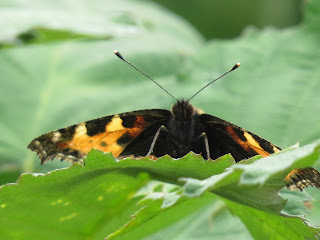 |
| Catton Park |
I have not been to Catton Park since January and a lot has changed since then. On my last visit, the grass was short, the ground was muddy and the trees were bare. Now it is late June and the leaves have long since grown back on the ancient oak trees which now tower over a glorious hay meadow in the warm, summer sunshine. It is quite a transformation.
 |
| The pond at the picnic area |
I had a spot of lunch in the dog-free picnic area before setting off for a walk. There is a pond here and it was full of tadpoles. Taking a closer look, you can see that most of them have developed hind legs. In the next few weeks, they will grow front legs and the tail will shrink, eventually becoming tiny froglets and leave the pond.
 |
| Tadpoles |
 |
| The hay meadow at grass level |
On my walk, I can't help but admire the beauty of the hay meadow. The sight and sound of the tall grass swaying in the light summer breeze is something quite poetic about it. I am not a botanist, but there must be several species of grass here. The 'flowers' of each grass species are varied. Some are big and tufty, while others form small clusters on the same stem. Poking out of the grass are patches of yellow of the bird's-foot trefoil and white of the ox-eyed daisies as well as a few other plant species like thistles. This splash of colour attracts the insects, especially butterflies. Meadow browns and common blues flutter over the meadow.
 |
| Ox-eyed Dasies |
 |
| Bird's-foot Trefoil |
 |
| A Plantain |
 |
| Ox-eyed Daisy with a small Longhorn beetle on it |
 |
| Greater Knapweed |
 |
| Meadow Brown |
 |
| Meadow Brown |
 |
| Common Blue |
 |
| Female Common Blue |
 |
| Swifts |
Swifts were circling above me, feeding on small airbourne insects. I find swifts fascinating. For the first two years of their lives, they feed, sleep and mate in the air without touching the ground once! It is incredible! They can turn half their brain off to sleep, while the other half stays awake before switching over. Strange but true! After two years in the sky, they finally touch ground as they are forced to build a nest.
 |
| Wren |
 |
| Scorpion Fly |
The hedgerows around the park was also buzzing with life. The brambles are in flower and has attracted the attention of bees and butterflies such as large skippers, small tortoiseshells and a comma. I also spot a scorpion fly. This is a female. Males have a 'stinger' at the end of its abdomen which looks like a stinger of a scorpion, except it is for show and is harmless.
 |
| Honey Bee |
 |
| Snail on a Bramble flower |
 |
| Small Tortoiseshell |
 |
| Rosebay Willowherb |

 |
| Large Skipper |
 |
| Bumblebee |
 |
| Comma |
 |
| Pineapple Weed |

























No comments:
Post a Comment